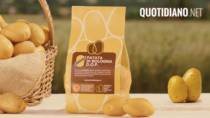Description
The Patata Rossa di Colfiorito PGI refers to the ripe tuber belonging to the species Solanum Tuberosum L., with red skin and pale yellow pulp.
Production Area
The production area of Patata Rossa di Colfiorito PGI is within the mountain area of the Umbrian-Marche Apennines and includes several municipalities in the provinces of Perugia, in the Umbria region, and Macerata, in The Marches region.
Production Method
The potatoes must be grown in soil that has been properly prepared, with be no clods or holes throughout its entire depth and exposed as much as possible to the structuring action of frost. Deep grubbing is carried out and at the time of planting, which takes place from March 1st to June 30th, and the land is harrowed level. The tubers must be at least 28 mm and can be implanted whole or after being cut longitudinally into pieces at least two days before planting. The latter can be planted either by hand or tuber planting machines, which deposit the tubers at a predetermined distance of 70-90 cm between one row and another, closing the furrows by levelling the soil. This is followed by ridging, which may be preceded by slight pre-ridging at the time of planting. The harvest, which can be carried out either manually or mechanically, must start on August 1st and finish by the end of November, with a permitted total production of no more than 40 tonnes per hectare. The potatoes are stored in large, ventilated nylon sacks or containers, which are stored in warehouses that provide the conditions necessary for the correct preservation of the tubers: allowing the surface to dry; facilitating the healing of damage caused during the harvest; preventing water forming on the potato’s surface. Anti-sprouting agents cannot be used while the product is in storage.
Appearance and Flavour
Patata Rossa di Colfiorito PGI is characterised by its intact skin, which is completely free of marks or damage caused by frost. It has a long, uneven oval shape and the opaque red skin is thin and rough: the pulp is compact and straw-yellow in colour.
History
The first evidence of red potato cultivation in the highland areas of Colfiorito and Casenove dates back to the second half of the 18th century. The area was an obligatory stopping point for armies on their way to The Marches region, and the potato was probably introduced by imperial troops journeying through the Papal State and during the subsequent French occupation during the Napoleonic period, as potatoes were a substantial part of the army’s diet.
Gastronomy
In order to preserve its characteristics, Patata Rossa di Colfiorito PGI must be kept at low temperatures and away from light. In Umbria it is used an ingredient in numerous recipes: the most typical example is gnocchi, with Trasimeno Pike or mutton sauce. It is also ideal for making bread, focaccia or puree, and can be served boiled, roasted, fried, or grilled. Another much loved delicacy is the sweet red potato doughnut. The annual Patata Rossa di Colfiorito festival, which takes place every August, provides a great opportunity to try the many ways this potato can be used.
Marketing
The product is marketed as Patata Rossa di Colfiorito PGI. It can only be sold in sealed labelled packaging, sacks and bags of various sizes, weighing anything from 1.5 to 10 kg. The product cannot be sold loose.
Distinctive Features
The Patata Rossa di Colfiorito PGI owes its distinctive qualities to the particular pedoclimatic characteristics of the production area, where it is grown at an altitude higher than or equal to 470 metres above sea level, which is characterised by the slightly acidic, permeable and deep siliceous soil containing stone. The high ground offers an ideal climate for the cultivation of this potato, as well as a lower risk of contracting diseases or parasitic infections.













